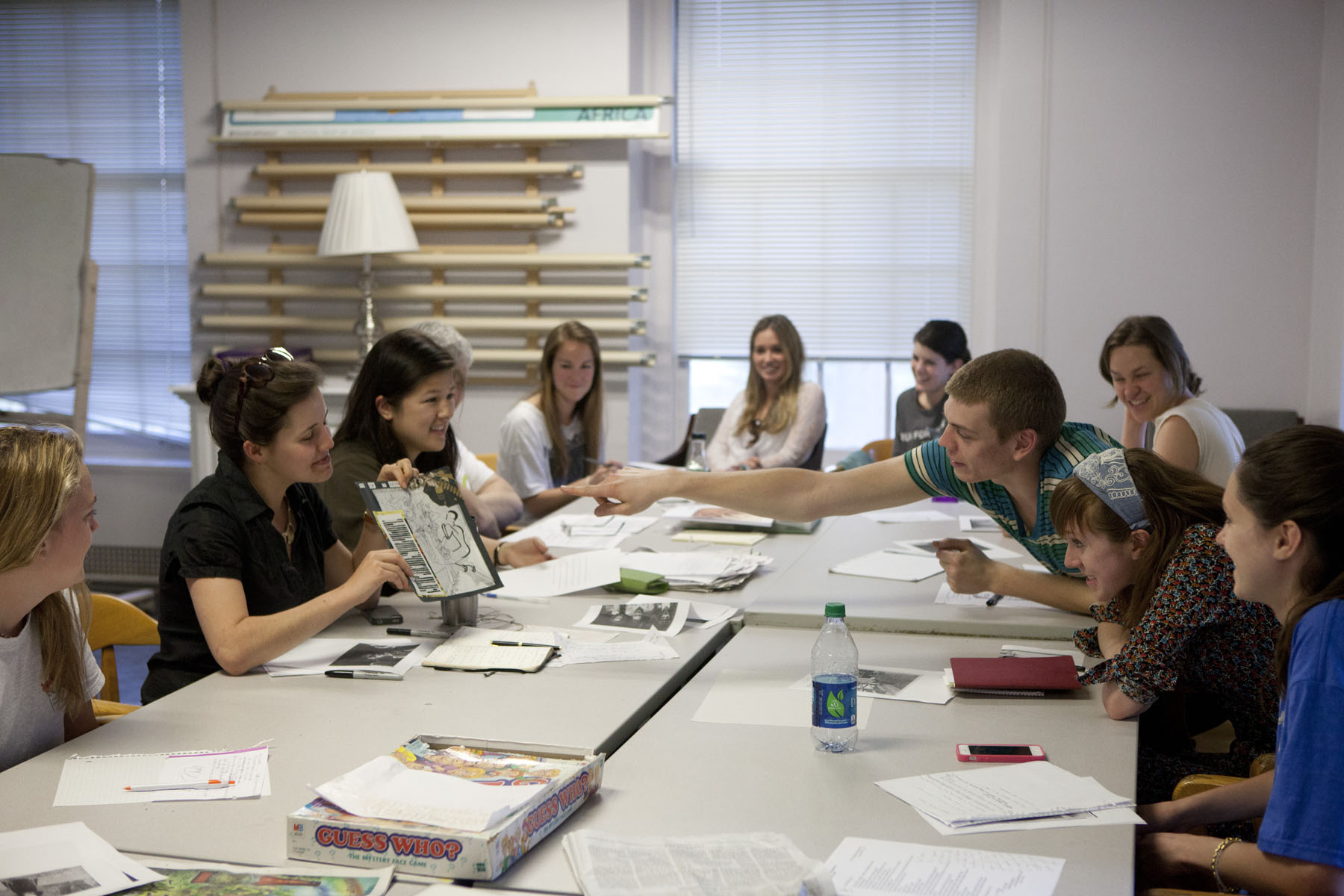Little did University of Virginia fourth-year students Isabelle Conner and Victoria Kornick know when they played together in an Alexandria preschool that nearly two decades later, they would end up playing teachers for real, leading a poetry class in the University of Virginia’s College of Arts & Sciences.
Part of the Cavalier Education Instructor program, a Student Council initiative that gives undergraduates the opportunity to share their passion for and knowledge of subjects outside the traditional curriculum, the two-credit, pass/fail course often had students sitting at a long table strewn with magazines, newspaper pages, construction paper, scissors, glue sticks and markers, searching for poetic inspiration.
Their purpose was to discover a grown-up creative process – “the alchemy of transforming everyday life into poetry,” as Conner and Kornick describe it on their syllabus.
Over the spring semester, 17 of Conner and Kornick’s fellow students “found poetry” by clipping sentences, phrases, words and lines from already-published poems and everyday articles, including obituaries and horoscopes, take-out menus, instruction booklets, cookbook recipes, field guides and travel guides. Through rearranging the pieces, they created new poems and works of collage.
Conner and Kornick also produced their high school literary magazine together and have remained close friends as they followed parallel tracks in their education. Both majored in the English department’s Area Program in Poetry Writing and have taken workshops with its founder and director, Lisa Russ Spaar, who teaches in the Creative Writing Program. In one of her classes, she introduced students to “found poetry,” and after that Conner and Kornick couldn’t stop looking for it.
Besides being a good experience in teaching, the friends thought it would be a good way to share their love of poetry with others. The instructors welcomed students who had little or no experience writing poetry, as well as more practiced poets. One of their aims was to nurture a greater comfort with reading and writing poetry, they said.
Spaar called the student-led course “extraordinary,” adding, “The students are having a marvelous time and producing wonderful work.”
“Found poetry” came out of the 20th-century Surrealist art and cultural movement beginning in the 1920s. Surrealist artists and writers such as André Breton, Salvador Dali and René Magritte sought to surprise viewers and readers, to jolt them out of restrictive customs and ideas by putting illogical things together and by writing in a stream-of-consciousness flow.
In their class, Conner and Kornick gave assignments and in-class exercises that encouraged making collages, using photography and adapted printmaking to challenge students, especially more experienced writers, to think visually about shaping poems and arranging words.
Kornick has taken several courses with U.Va. art professor Dean Dass, who teaches all levels of printmaking, as well as printmaking courses that focus on the art of the book and papermaking.“In this course, we want to introduce the practice of making poems to students who have never had the time or space in their schedules to take a poetry class, had thought of poetry writing as intimidating or had never considered it as an academic pursuit,” Conner and Kornick wrote in their course description.
Just as some forms of poetry have a set structure – writing a sonnet, for example, requires 14 lines, rhyming in a certain pattern – using language that has been found is another kind of format. Thus the instructors taught students about the elements of poetry and discussed “the poetics of found language and how we can make language ‘ours’ even if it is found,” they said.
One student, Jamie McLemore, said she hadn’t understood poetry very well before and never considered writing it, but now feels much more confident, since she tackled assignments every week. A student in the Curry School of Education, she’s planning to go into elementary education and said what she learned in the found poetry course will help her teach her young pupils.
“It’s exciting to know there are all these ways to make poetry,” she said.
In one exercise, students took a contemporary American poem and re-wrote it from the opposite or negative perspective, using antonyms in place of nouns and actions.
Poet Carl Phillips begins his poem, “Custom,” with these lines:
“There is a difference it used to make,
seeing three swans in this versus four in that
quadrant of sky. I am not imagining. It was very large, as its
effects were.”
Lily Burkhalter wrote in a negative tone of voice in her poem, “Coincidences of Disintegration: Matrimonial”:
“No, it doesn’t alter a thing,
living in this single-bedroom high-rise stacked with cardboard boxes
and an ashtray of pennies.
You are fantasizing. Fine, but the difference is insignificant ...”
In another exercise, Eleanor Blaine took phrases from a book on the reading list, “The Poetics of Space,” by Gaston Bachelard, and used them in an original poem, “Charlotte, North Carolina”:
“I yearned for the uncertainty of a long country road
but words carry with them obligations.
that memory you keep in an engraved silver box
like a heart that confides in no one --
in which ready to open drawer
will you put it?”
Will Frazier, another poetry major who’s finishing his third year, said he unexpectedly liked the constraints inherent in found poetry and putting words together in new ways.
Frazier, like Conner and Kornick, is so taken with found poetry methods, he plans to keep the course going and teach it next year with another student.
Kornick will pursue her M.F.A. in poetry writing at New York University next fall, and Conner is planning to live and work in the city, as well. No doubt they will find poetry, and each other, wherever they are.
Media Contact
Article Information
April 29, 2013
/content/uva-students-get-creative-found-poetry

